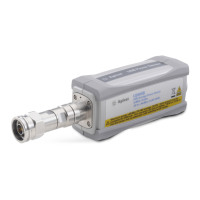Power Sensor Remote Operation 1
U2000 Series Programming Guide 17
Using Frequency Dependent Offset Tables
This section describes how to use frequency dependent offset tables. These
tables give you the ability to compensate for frequency effects in your test
setup.
Overview
If the [SENSe[1]]:CORRection:CSET2:STATe command is OFF, the
frequency dependent offset tables are not used. When
[SENSe[1]]:CORRection:CSET2:STATe is ON, the frequency dependent
offset tables are used, providing you with a quick and convenient method of
compensating for your external test setup over a range of frequencies. Note
that when selected, frequency dependent offset correction is IN ADDITION to
any correction applied for sensor frequency response. The power sensor is
capable of storing 10 frequency dependent offset tables of 80 frequency points
each.
To use frequency dependent offset tables you:
1 Edit a frequency dependent offset table if necessary.
2 Select the frequency dependent offset table.
3 Enable the frequency dependent offset table.
4 Zero and calibrate the power sensor.
5 Specify the frequency of the signal you want to measure. The required
offset is automatically set by the power sensor from the frequency
dependent offset table.
6 Make the measurement.
Figure 1- 1 illustrates how frequency dependent offset tables operate.

